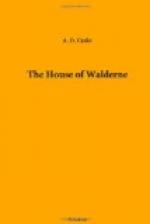In writing the chapters which describe medieval Oxford, the author had the advantage of an ancient map, and of certain interesting records of the thirteenth century, so that the picture of scholastic life and of the conflicts of “north and south,” etc. is not simply imaginary portraiture. The earliest houses of education in Oxford were doubtless the religious houses, beginning with the Priory of Saint Frideswide, but schools appear to have speedily followed, whose alumni lodged in such hostels as we have described in “Le Oriole.” The hall, so called (we are not answerable for the non-elision of the vowel) was subsequently granted by Queen Eleanor to one James de Hispania, from whom it was purchased for the new college founded by Adam de Brom, and took the name of Oriel College.
Two other points in this family history may invite remark. It may be objected that the Old Man of the Mountain is too atrocious for belief. The author can only reply that he is not original; he met the old man and all his doings long ago, in an almost forgotten chronicle of the crusades, especially he noted the perversion of boyish intellect to crime and cruelty.
Lastly, in these days of incredulity, the supernatural element in the story of Sir Roger of Walderne may appear forced or unreal. But the incident is one of a class which has been made common property by writers of fiction in all generations; it occurs at least thrice in the Ingoldsby Legends; Sir Walter Scott gives a terrible instance in his story of the Scotch judge haunted by the spectre of the bandit he had sentenced to death {2}, which appears to be founded on fact; and indeed the present narrative was suggested by one of Washington Irving’s short stories, read by the writer when a boy at school.
Whether such appearances, of which there are so many authentic instances, be objective or subjective—the creation of the sufferer’s remorse—they are equally real to the victim.
But the author will no longer detain the reader from the story itself, only dedicating it to the kind friends he met at Waldron during his summer holiday in eighteen hundred and eighty-three.
Prologue.
It was an ancient castle, all of the olden time; down in a deep dell, sheltered by uplands north, east, and west; looking south down the valley to the Sussex downs, which were seen in the hazy distance uplifting their graceful outlines to the blue sky, across a vast canopy of treetops; beneath whose shade the wolf and the wildcat, the badger and the fox, yet roamed at large, and preyed upon the wild deer and the lesser game. It bore the name of Walderne, which signifies a sylvan spot frequented by the wild beasts; the castle lay beneath; the parish church rose on the summit of the ridge above—a simple Norman structure, imposing in its very simplicity.




